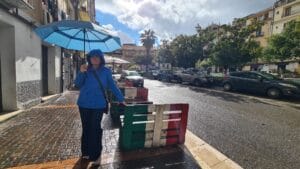
Lamezia Terme: The Blog That Nearly Didn’t Happen – By Andy
A2Z Wander | Our Blog A Rainy Arrival (and a Slight Hangover) Lamezia Terme almost didn’t get its own blog post. There’s only so many
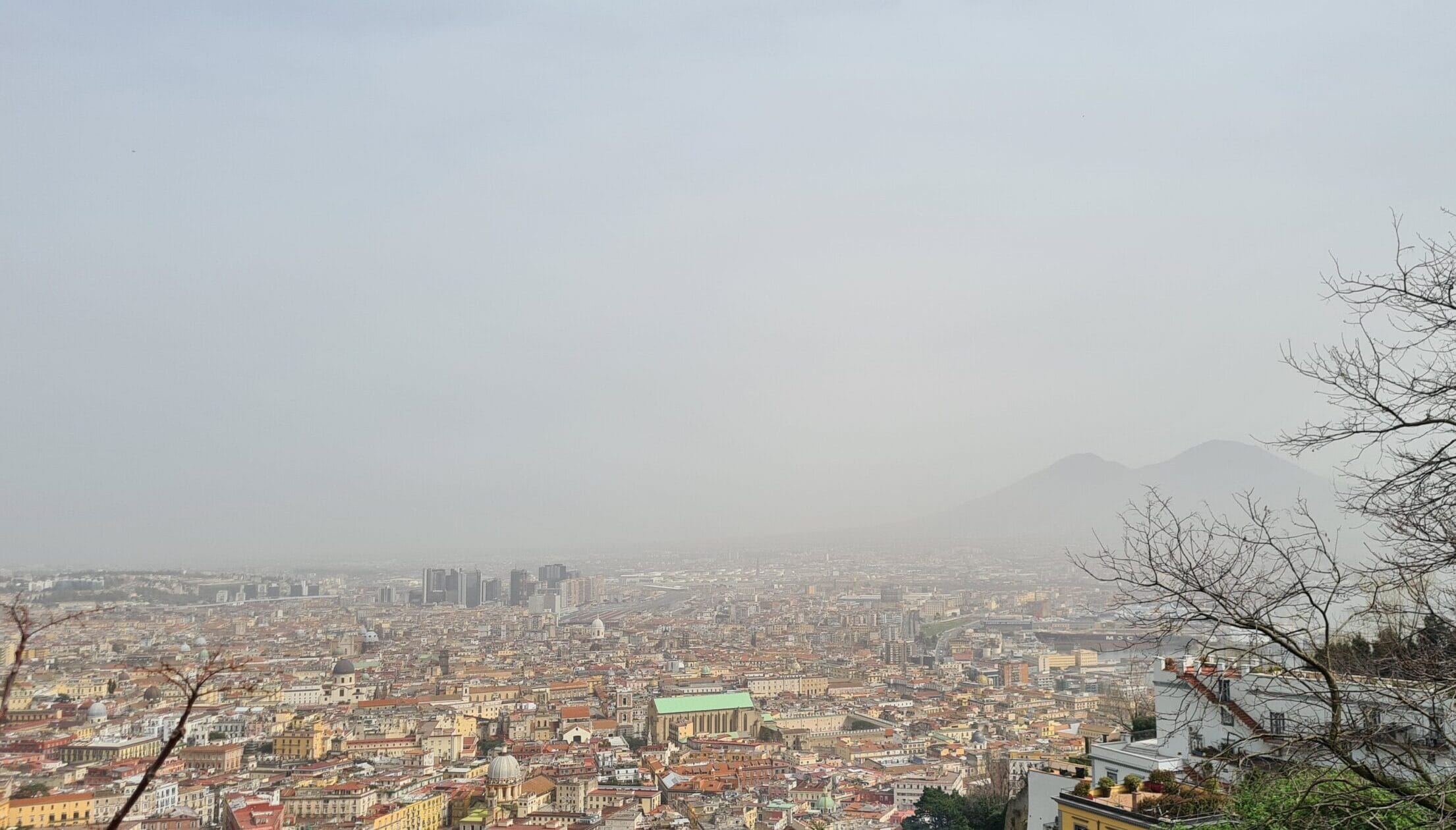
After the joy (and slight overindulgence) of our street food tour, we were hungry for more, not food this time, but for a different view of Naples. So, we ambitiously signed up for two tours in one day. Because, why not? We were here to learn, explore… and walk off some of that pizza!
There’s so much to Naples—its layers of history, its underground tunnels, its coastline dotted with beautiful islands. Even with five days and the best-laid plans, we knew we weren’t going to cover everything. But we were determined to give it a good go.
Of course, the weather had other ideas. The forecast when we arrived was ominous, so we resigned ourselves to the fact that Naples—and the weather gods—would set the pace.
Funnily enough, when we arrived in the city, it was dry. Getting from the heaving central station to our accommodation without getting flattened by scooters, yelling at each other, or taking a wrong turn was what we needed to worry about. Deciding to stay in a non-touristy area could be a blessing or a curse, we would find out in time.
After a five-hour, 548km train journey from Siena (via Florence), we were keen to stretch our legs, dump our bags, and despite the looming clouds,we headed straight out.
Five minutes later, we realised the clouds weren’t just for decoration.
If this were one of those blogs filled with affiliate links, this is where I’d insert a glowing recommendation for umbrellas. Andy, ever the forward thinker, had asked Santa (a.k.a.. Claire, Andy’s sister) for a windproof, indestructible travel umbrella for Christmas. And Santa, bless her, had delivered.
Except… we’d left it in the room.
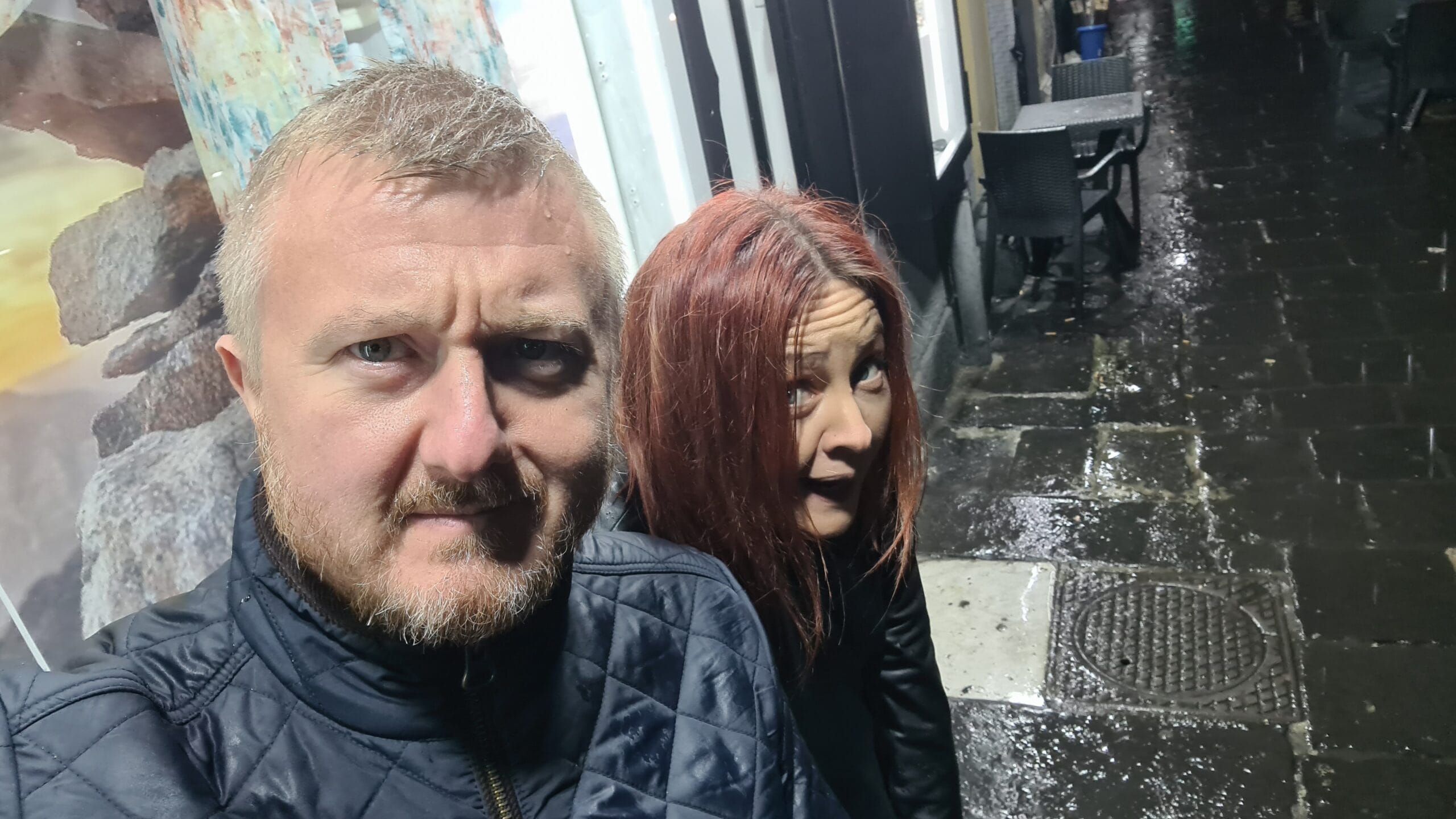
Looking back, it’s funny. Actually, it was funny at the time—what else can you do when raindrops the size of saucers are bouncing off your head? You laugh. And, because this is Naples, you dive into the nearest coffee shop—and then a pizzeria.
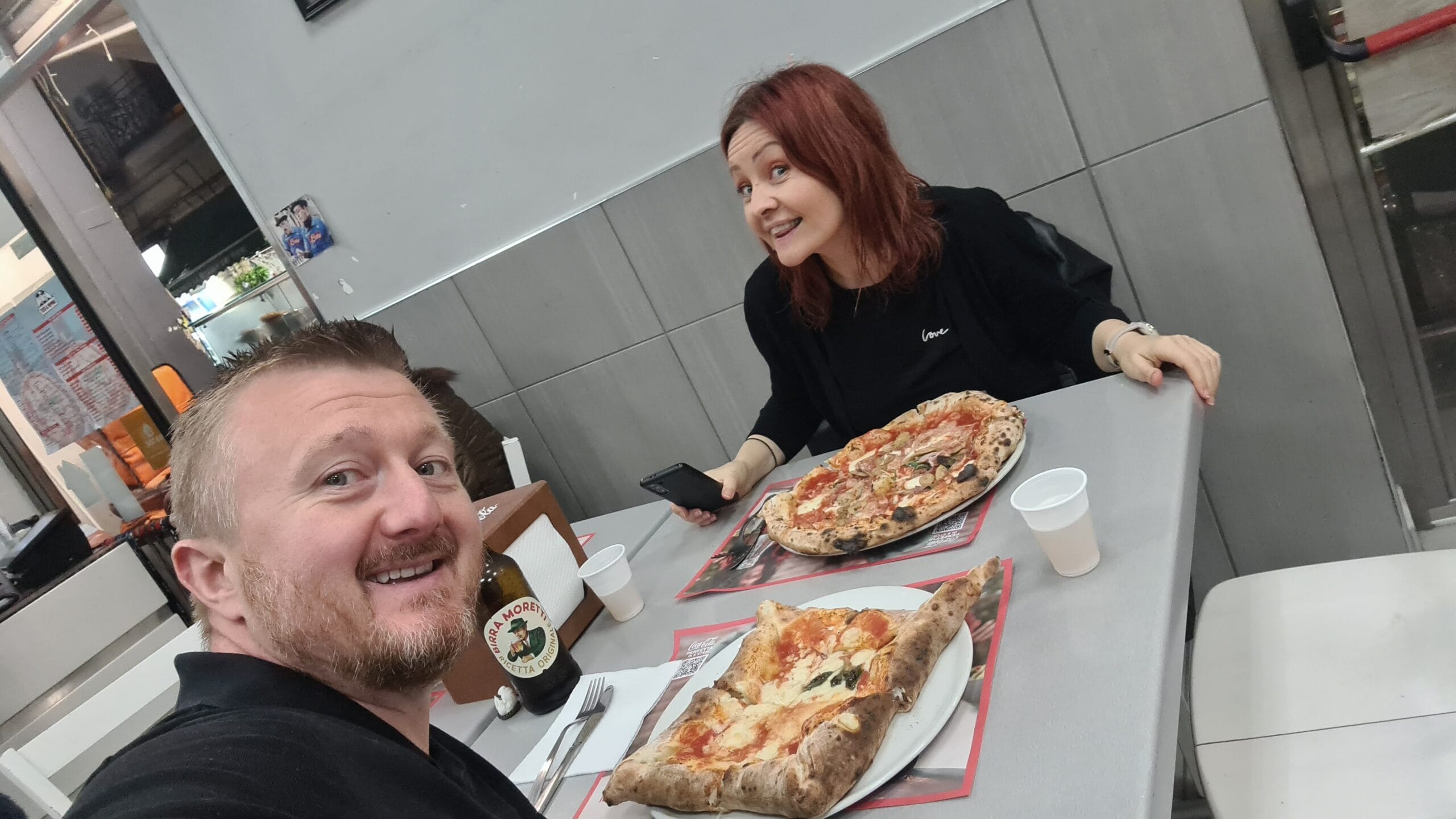
Learning the soggy lesson from our arrival, we were prepared for our double tour day. Umbrella? Packed. Layers? On. Spirits? Undampened. Naples may have caught us out once, but this time we were ready for whatever weather or chaos it decided to throw at us. And good thing too, because we were about to see (erm…sort of) the city from an entirely new angle, from above.
Our panoramic tour promised something different: a chance to step back from the clatter and commotion of the streets and take in Naples in all its sprawling, volcanic glory.
From hilltop views to hidden alleyways, our second tour in Naples gave us a whole new perspective — literally and figuratively.
Our meeting point was the funicular station, which would take us from Via Toledo to the hilltop area of Vomero. Naples has four funicular lines; ours had four stops, connecting the upper and lower districts. A unique and practical way to navigate the hilly terrain, they run from 7 am to 10 pm daily, and are a bargain at €1.10 per ticket. Handily, it’s on the same system as the metro, so a day ticket also includes the four funiculars.
Stepping out into the elegant street, Vomero felt like a separate city watching over Naples below. And the reason it feels different is because it is.
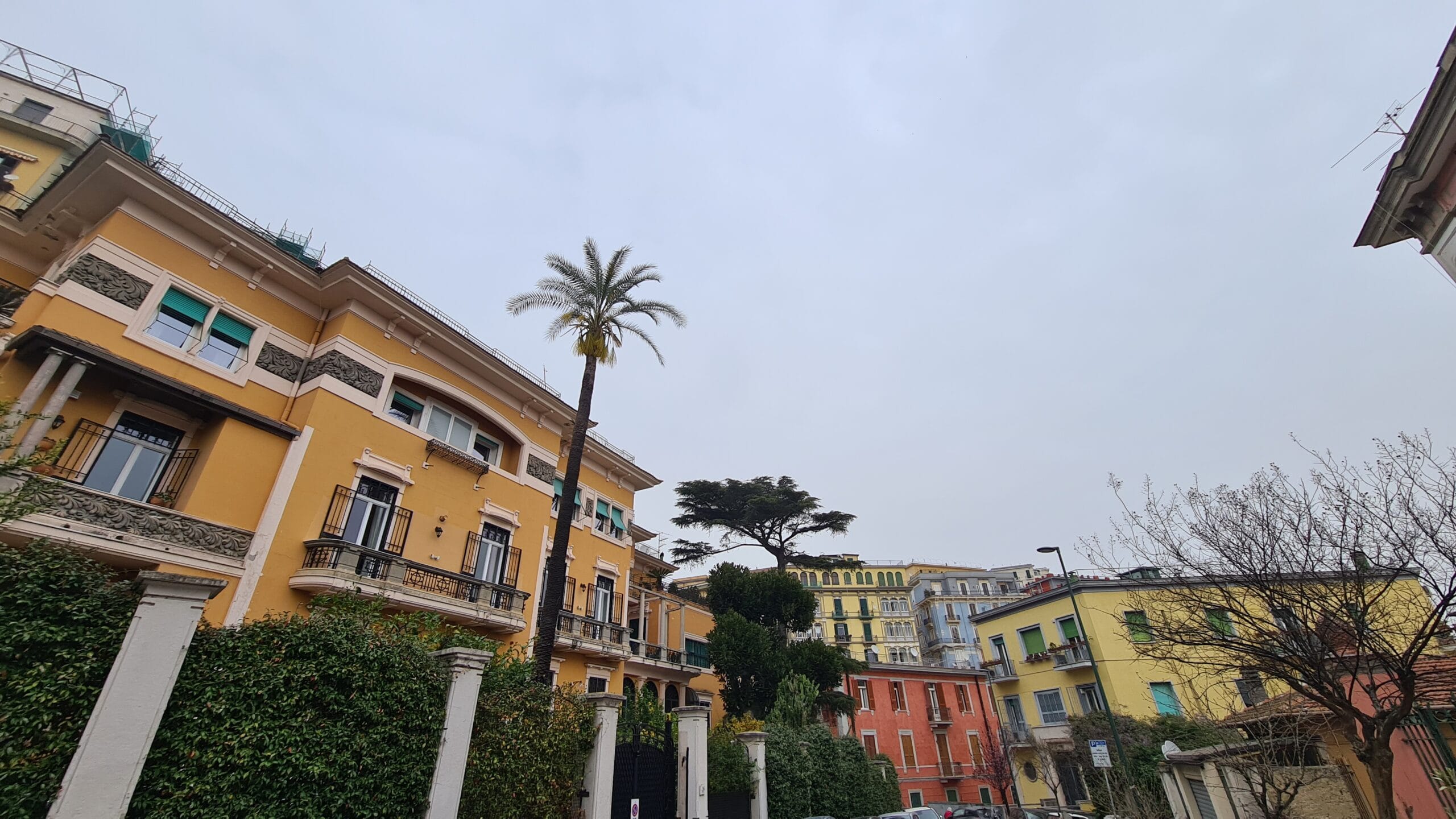
Vomero’s history sets it apart from the more chaotic heart of Naples. Built only from the late 1800s onwards, this hilltop neighbourhood quickly became a sought-after retreat for noble families, drawn by its pure air, grand villas, and promise of a better quality of life. In contrast to the crowded, often squalid conditions of the city centre, Vomero offered space, health, and elegance — and it still does today. Even now, the best hospitals are found up here, a legacy of its reputation for clean living.
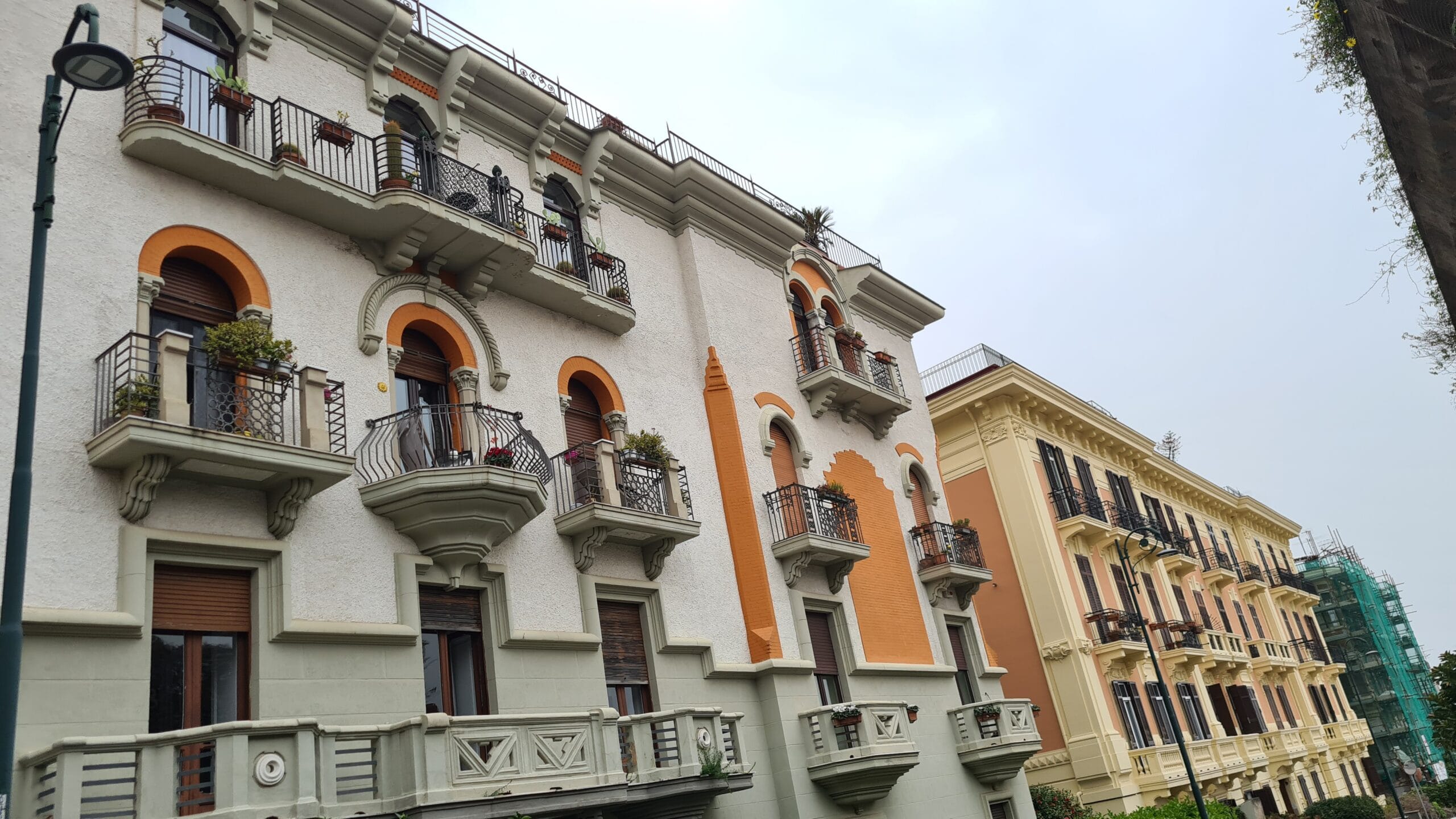
By 1900, with Naples undergoing a massive wave of rebuilding, Vomero, along with the adjacent Arenella district, was ready to become part of the greater Neapolitan sprawl. New residences and businesses sprang up, and Piazza Vanvitelli became a showcase for the popular Liberty (Art Nouveau) architectural style. Vomero was no longer just an enclave of exclusive villas; it was becoming gentrified, attracting the city’s growing middle class.
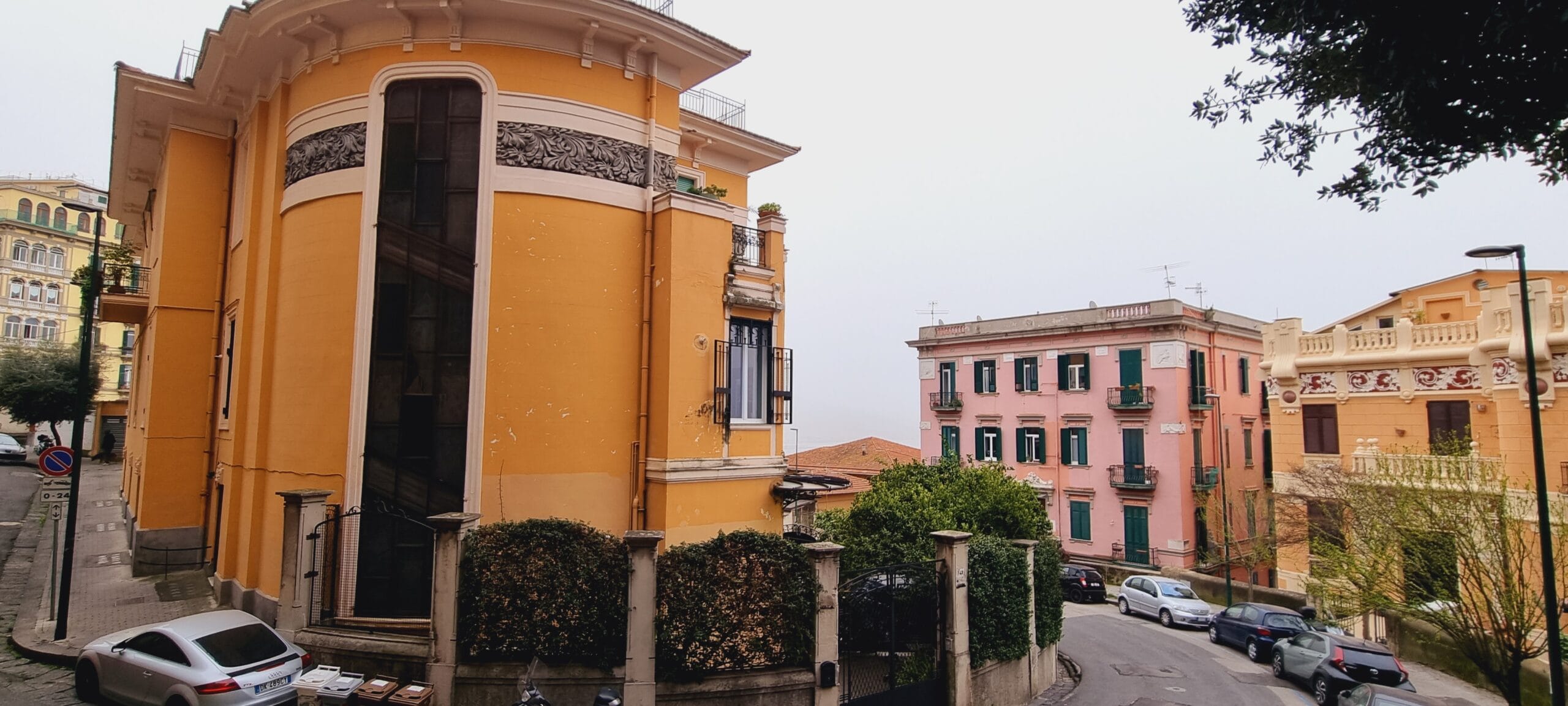
Today, Vomero blends the intoxicating vibrancy of Naples with a calmer, more refined charm. With its leafy streets, lively cafés and bars, and chic shopping, it’s a relaxed yet buzzing part of the city, all topped off with some of the finest views Naples has to offer. For those overwhelmed by the downtown streets, this is an ideal place to stay.
From our vantage point, Naples stretched out before us — a vast, living patchwork of terracotta rooftops, grand buildings, church domes, and air conditioning units , twisting streets, and hidden courtyards. To the right, the Posillipo hill rolled away towards the sea, and across the vast bay, the silhouette of Vesuvius loomed… or kinda skulked in the background. Thanks to the low cloud and mist, the ever-present volcano was barely a shadow on the horizon.
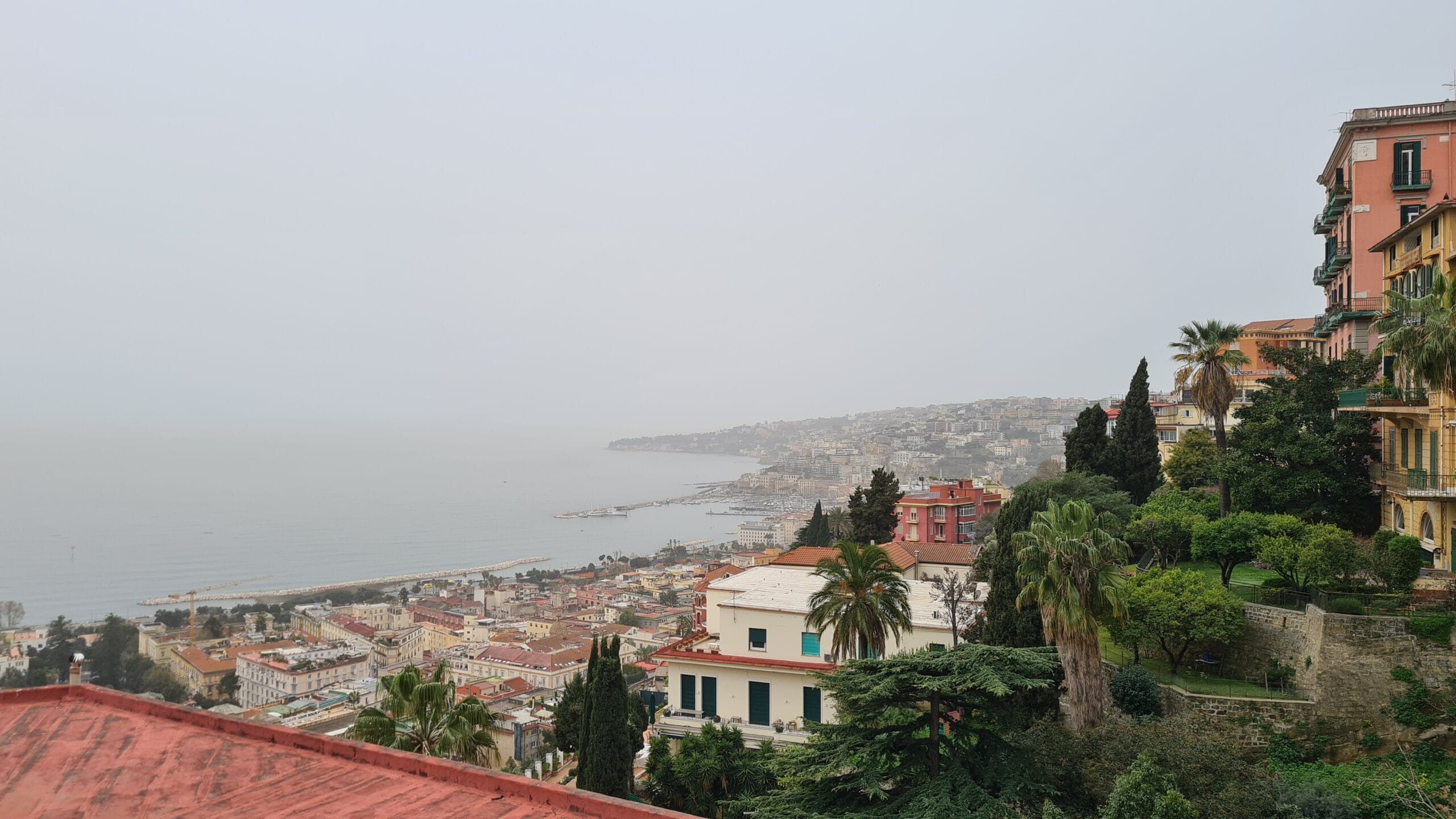
Most visitors to Naples arrive with one volcano on their mind: Vesuvius. Towering over the bay with its unmistakable twin peak silhouette, it’s the dramatic icon of the region, infamous for the destruction of Pompeii. But as our guide explained — and as we soon came to understand — it’s not Vesuvius that keeps Neapolitans awake at night. That particular threat, she told us with a wry smile, is more of a concern for those living in towns like Ercolano, close to Pompeii. For the people of Naples, the real danger lies to the west: Campi Flegrei.
This vast, ancient volcanic area, whose name means “Fiery Fields” stretches beneath the municipalities of Pozzuoli, Bacoli, and Monte di Procida, and even under parts of the Gulf of Naples itself. Technically a caldera — the collapsed mouth of a supervolcano — Campi Flegrei consists of 24 craters and volcanic structures, many of which still show signs of life: steaming solfataras, bubbling mud pools, and bursts of sulphurous gas.
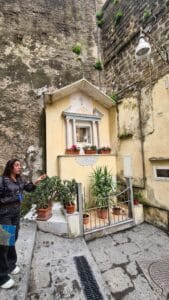 One night during our stay, a 4.4 magnitude earthquake shook the city awake. (We slept through it, we were on the first floor and nearly 10km away from the epicentre) near Pozzuoli, and while the damage was relatively minor, it served as a stark reminder of the volatile ground beneath our feet. These tremors are linked to bradyseism, a geological phenomenon unique to this region, where the land itself slowly rises and falls due to subterranean volcanic activity. Or to use Alessandra’s words, ”the campi is breathing”.
One night during our stay, a 4.4 magnitude earthquake shook the city awake. (We slept through it, we were on the first floor and nearly 10km away from the epicentre) near Pozzuoli, and while the damage was relatively minor, it served as a stark reminder of the volatile ground beneath our feet. These tremors are linked to bradyseism, a geological phenomenon unique to this region, where the land itself slowly rises and falls due to subterranean volcanic activity. Or to use Alessandra’s words, ”the campi is breathing”.
It’s this same process that caused the ancient Roman city of Baia — once a glamorous spa retreat for emperors and elites — to sink beneath the sea, earning it the nickname The Sunken Pompeii.
Campi Flegrei has captivated people for millennia. The Romans, rather than fearing its power, were drawn to its natural thermal springs and steam-filled caves, building luxurious villas and bathhouses across the landscape. The remnants of that decadent past can still be explored at the Campi Flegrei Archaeological Museum in the Aragonese Castle.
Despite its reputation in scientific circles, where it’s sometimes labelled a “supervolcano”, daily life in Naples goes on with typical resilience. Earthquakes are part of the rhythm of life here. Neapolitans live with it. They always have.
Standing high above the city, it was humbling to think of everything that lay beneath our feet, from ancient Roman villas and sunken cities to the restless, rumbling caldera of the Campi Flegrei. Naples isn’t just layered with history; it’s built on it, quite literally. And yet, despite the deep forces at play below, life carries on above with colour, character, and irresistible charm.
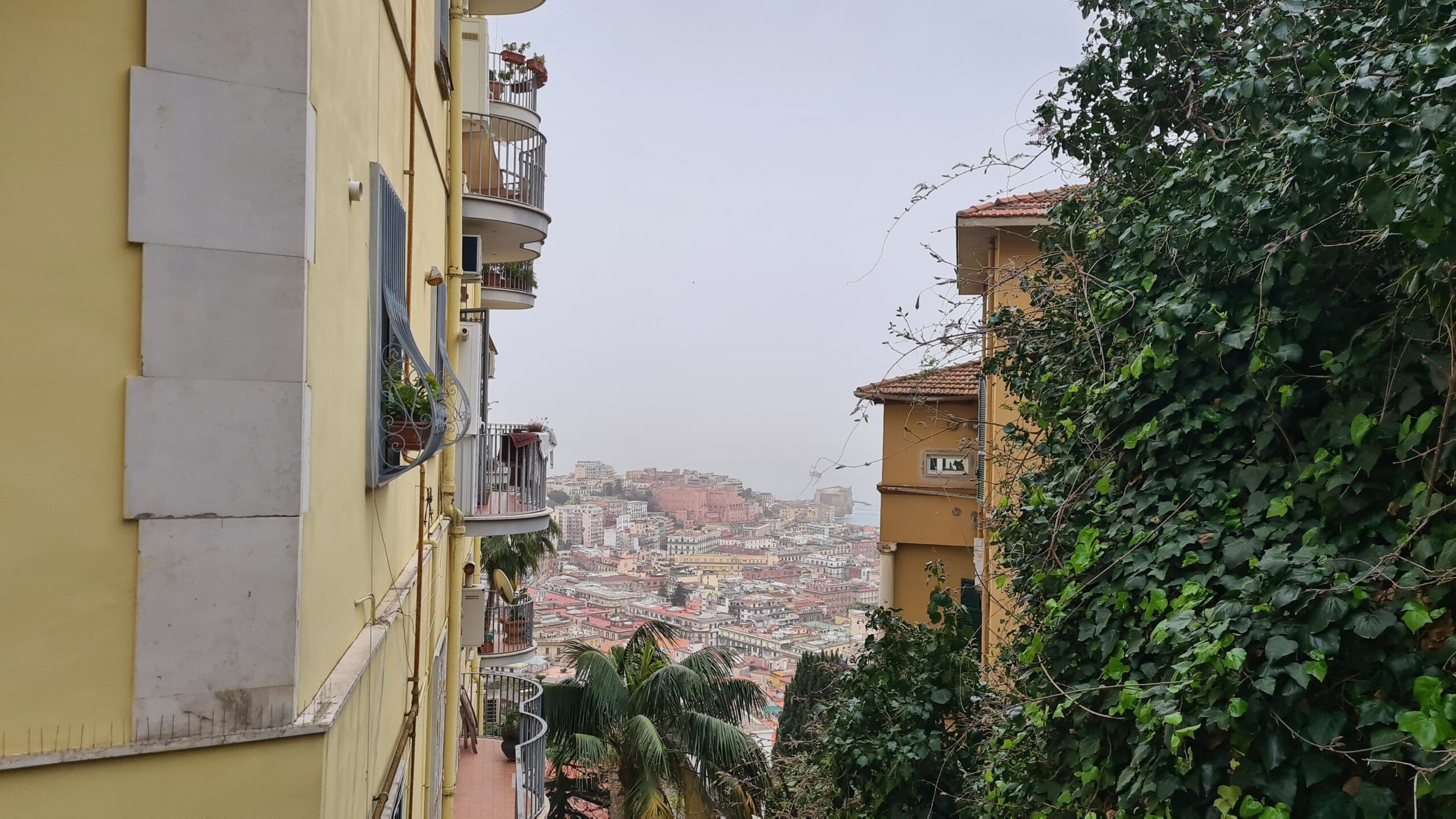
Even on this misty morning, the sweeping view was impressive. The buildings, with their faded pastels and flashes of colour, brought warmth to the grey skyline, and one thing was unmistakable: the sheer, sprawling scale of Naples. It’s only when you see it from above that you truly appreciate the size, the life, and the layers — both visible and hidden — of this extraordinary city.
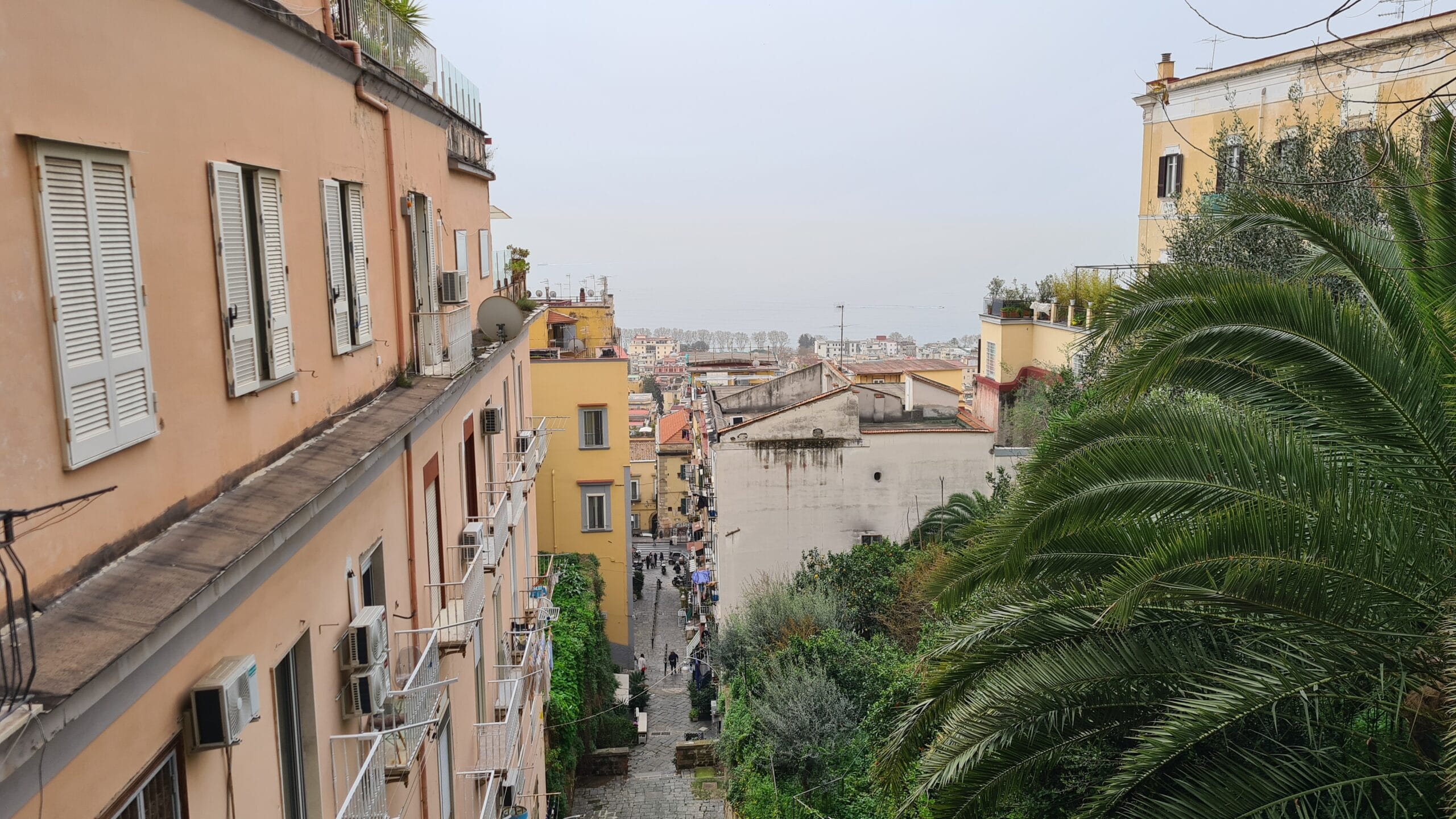
Our guide, Alessandra, perhaps aware that the weather was not on our side and the views somewhat dulled, took the opportunity to share some local knowledge and folklore about the foundations of Naples.
Founded by the Greeks, Naples is one of the oldest continually inhabited urban areas in the world. Officially, the city was established around 600 BCE as Neapolis (“New City”), close to the even older settlement of Palaepolis — itself linked to the name of the siren Parthenope.
The origins of Naples are steeped in myth and passion. Love, in its many forms, seems to be the city’s true foundation stone. Over time, three enchanting versions of the Parthenope myth have emerged, each offering a different glimpse into the heart of Naples.
In the first and perhaps most famous legend, Parthenope was a mermaid who lived among the rocks of the sea. When Ulysses (Odysseus) sailed past, she tried to seduce him with her enchanting song. But Ulysses, having been warned of the sirens’ deadly lure, resisted her call. Heartbroken by her failure, Parthenope threw herself into the sea. Her body washed ashore at the little island of Megaride, where it is said she dissolved into the land itself — her head forming the hill of Capodimonte, her tail stretching towards Posillipo. Thus, Naples was born from her sorrow and devotion.
In another version, shaped by the Neapolitan writer Matilde Serao, Parthenope was not a siren but a Greek girl deeply in love with the Athenian hero Cimone. Forbidden by her father to marry her true love, Parthenope fled with Cimone across the sea. They arrived in the Gulf of Naples, where they could live freely, away from disapproving eyes. Their families eventually followed, settling nearby and giving rise to a new community. In this telling, Parthenope did not die; she lived on, became the mother of twelve children, and is remembered as the founding matriarch of the Neapolitan people, still lovingly watching over the city today.
In a version of the legend told in the 1800s, Parthenope lived along the shores of the Gulf of Naples, where she met a centaur named Vesuvio. Their love began when Eros, the god of love, struck them with one of his arrows, binding their hearts together. For a time, they were inseparable — wild, joyful, and devoted to one another.
But their happiness stirred jealousy. Zeus, who also loved Parthenope, could not bear to see her with another. In a fit of rage, he separated them forever, turning Vesuvio into a volcano at the edge of the bay, so that Parthenope would always see him — but never touch him. Overcome with grief, she cast herself into the sea. Her body was carried by the waves to the island of Megaride, where she dissolved into the land and became the city of Naples — a tribute to a love lost, but never extinguished.
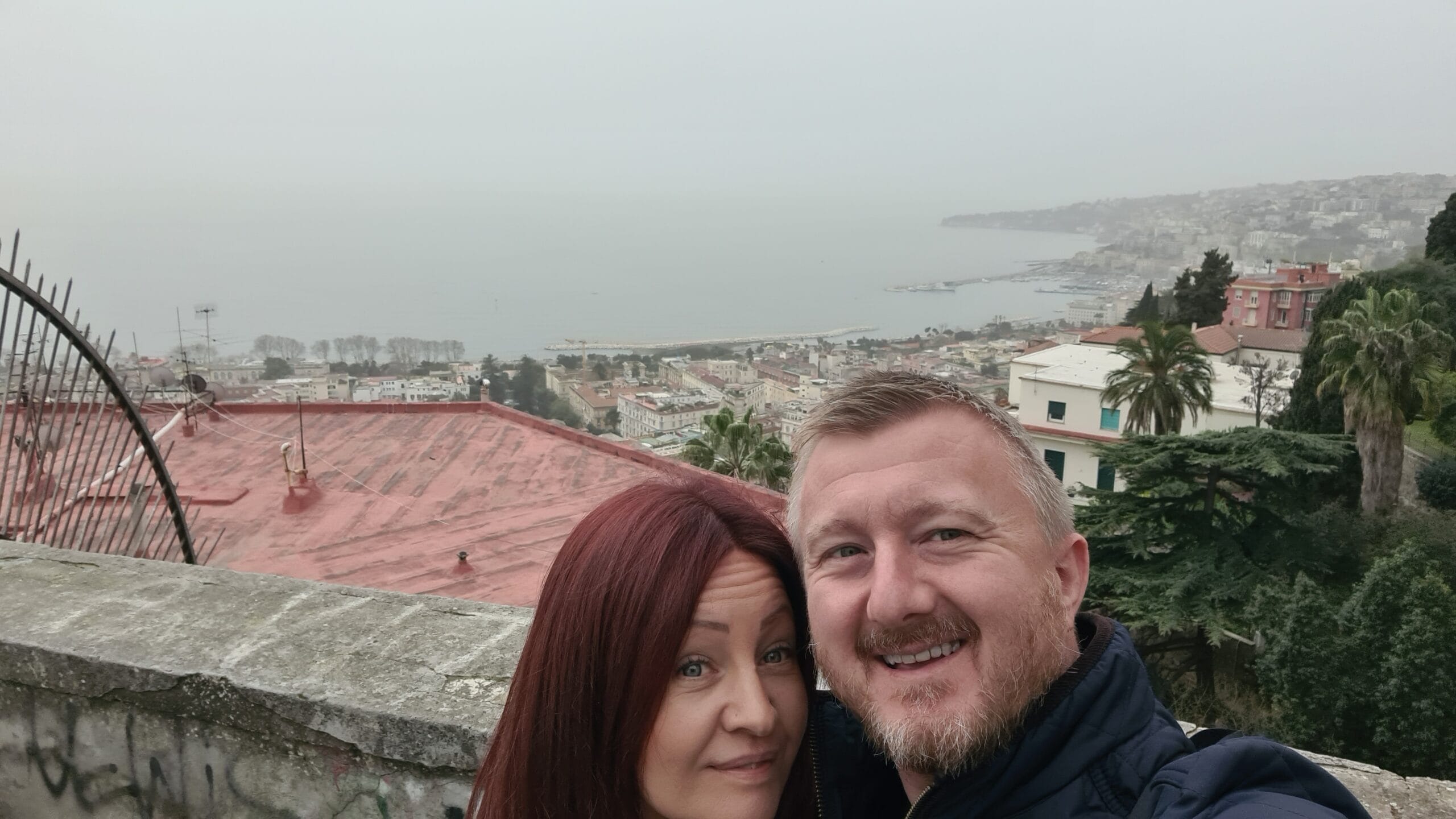
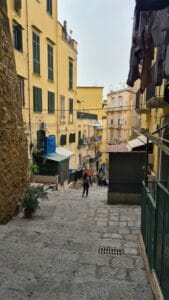
Leaving the hilltop behind, we began our descent through the Pedamentina, a network of steep, winding stairways that spills down the hillside like a ribbon. More than 400 ancient stone steps connect Vomero to the historic centre below, offering glimpses of Naples at every turn — rooftops, secret gardens, and the shimmering sweep of the bay beyond.
As we made our way south, back into the bustle of downtown, we entered the Quartieri Spagnoli — the Spanish Quarters — one of the most famous and fascinating neighbourhoods in the city. Our guide, who grew up in these very streets, spoke with the kind of passion and pride that only a true local can. And through her stories, the soul of the Quartieri came alive right in front of us.
Tucked just off the historic centre, the Quartieri Spagnoli have long been the subject of both fascination and fear. For many years, they were painted as a place to avoid: a tangled warren of narrow alleys, once considered one of the most dangerous parts of Naples.
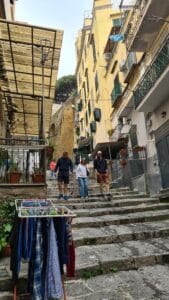 Yet today, the Quartieri have been reimagined as one of the city’s most captivating and authentic areas, where life spills vibrantly into the streets, washing lines flutter overhead, and the scent of home-cooked food drifts from open windows.
Yet today, the Quartieri have been reimagined as one of the city’s most captivating and authentic areas, where life spills vibrantly into the streets, washing lines flutter overhead, and the scent of home-cooked food drifts from open windows.
The story of the Quartieri Spagnoli begins in the 16th century, during the Spanish occupation of Naples. King Charles V, ruler of much of Europe at the time, ordered the construction of these densely packed districts to house Spanish soldiers close to the city centre, ready to stamp out any rebellious stirrings among the Neapolitan population. The strategic layout — a labyrinth of tight alleyways and towering buildings — was designed for swift movement and firm control. But with the soldiers came darker elements: crime, black market trade, and a thriving undercurrent of prostitution, giving the neighbourhood a reputation that lingered for centuries.
Today, the Quartieri Spagnoli is often described as cinematic, a place where the true soul of Naples shines through. Though its troubled past is never forgotten, the spirit of resilience and community has transformed it into a must-visit for anyone wanting to experience the real, beating heart of the city.
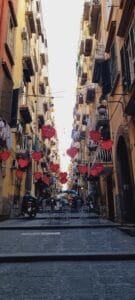 The Quartieri Spagnoli are far more than a historic curiosity — they are a living, breathing centre of Neapolitan culture. Woven through the maze of alleys are traditional craft workshops, hidden shops, and family-run trattorias serving up local favourites. Some of Naples’ best-loved pizzerias are tucked away here, where recipes are handed down through generations and the art of pizza-making is practically a religion in itself.
The Quartieri Spagnoli are far more than a historic curiosity — they are a living, breathing centre of Neapolitan culture. Woven through the maze of alleys are traditional craft workshops, hidden shops, and family-run trattorias serving up local favourites. Some of Naples’ best-loved pizzerias are tucked away here, where recipes are handed down through generations and the art of pizza-making is practically a religion in itself.
Religious festivals and processions are still a vibrant part of life in the Quartieri. At certain times of year, the streets come alive with lights, banners, and colourful decorations as residents celebrate centuries-old Catholic traditions. These events offer an incredible glimpse into the city’s soul — a mix of deep faith, community pride, and sheer, joyous energy that is uniquely Neapolitan.
As Alessandra explained, ‘Here, the streets don’t just have history — they have heart.’
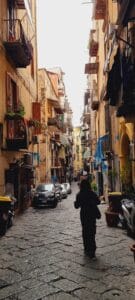 The Quartieri Spagnoli have faced their share of struggles. Overcrowded housing, poverty, and unemployment once made the area a byword for hardship.
The Quartieri Spagnoli have faced their share of struggles. Overcrowded housing, poverty, and unemployment once made the area a byword for hardship.
Keenly aware that I’m just a few feet from people’s homes, I ask Alessandra how the locals feel about us, tour groups (thankfully a very small one) and if it’s ok to take photos.
“People here were fed up. They’d had enough of the crime, the way nothing was done. They wanted change. They’re happy that you’re here.”
In recent years, grassroots projects and local initiatives have worked hard to breathe new life into the district, improving living conditions and restoring pride in its heritage. Tourism now plays an important part in the area’s revival. Visitors come looking for a taste of the real Naples — gritty, vibrant, and full of heart. Yet this growing interest also brings challenges, with concerns about gentrification and the delicate balance between preserving the district’s unique identity and meeting the needs of a modern city.
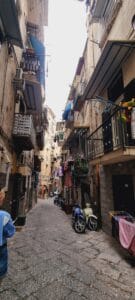 As we wandered deeper into the Quartieri Spagnoli, Alessandra, our guide, shared more about daily life here, with a grin and a warning: “There are about 15,000 people living here… and every one of them has a scooter, so watch out!”
As we wandered deeper into the Quartieri Spagnoli, Alessandra, our guide, shared more about daily life here, with a grin and a warning: “There are about 15,000 people living here… and every one of them has a scooter, so watch out!”
The neighbourhood’s dense layout — around eighteen streets crossed by twelve narrow lanes — creates a feeling of both closeness and claustrophobia. The buildings, many of them centuries old, are constructed from tuff stone, a soft volcanic rock abundant in the region. Tuff has shaped much of Naples, quite literally; it’s easy to quarry and build with, but over time, it’s prone to erosion and structural problems.
In the Quartieri, you can see this up close: cracks in the walls, exposed stone, and a tangle of electrical wires strung like washing lines outside the buildings because the walls can’t be drilled into. It’s a vivid reminder of the challenges the community faces — making do and mending, adapting century-old structures to modern life with a resourcefulness that is pure Neapolitan spirit. Give people problems and they get creative.
In the Quartieri Spagnoli, the boundary between public and private life often feels blurred. Walk through the tight lanes and you might catch a glimpse of someone cooking, ironing, or even stepping out of the shower — all just a few feet from the street. This isn’t rudeness or curiosity; it’s simply the reality of living in the bassi – tiny, street-level homes that are an unmistakable part of Naples’ historic quarters.
There are thought to be around 40,000 bassi across the city, each usually made up of just one or two small rooms, often housing entire families. With such limited space inside, life naturally spills outdoors. Doorways become sitting rooms, pavements turn into kitchens, and conversations flow between open windows and passing scooters.
Originally the domain of working-class Neapolitans, today the bassi are home to a more diverse mix of residents, including immigrants from Sri Lanka, Bangladesh, and Central Africa. Despite the sense of community and resourcefulness that shapes daily life, the living conditions are tough. High humidity and poor ventilation mean black mould is a common problem, and privacy is almost non-existent. Yet, there’s a vibrancy here that’s hard to miss — a patchwork of lives lived half-inside, half-outside, woven tightly into the fabric of the city itself.
In the Quartieri Spagnoli, it’s not just a street you walk down — it’s a series of open living rooms, stitched together by daily life, family ties, and the determined spirit of Naples.
I’m reminded of a sentence from a reading text that I teach, ‘It takes a whole village to raise a child’. Alessandra confirms that you have no choice but to be good friends with your neighbours, who are, in fact, more like family. In and out of each other’s houses, the street becomes your living room by necessity because of the lack of space. Life here happens on the streets.
Pignasecca: A Market with a Mischievous Past
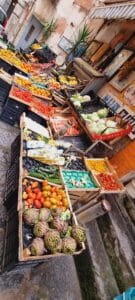 After soaking up the stories of the Quartieri, it felt right to end our day somewhere equally full of life — Pignasecca, Naples’ oldest open-air market. A riot of noise, colour, and irresistible smells, this bustling stretch of street is a daily ritual for many Neapolitans and a feast for the senses for anyone passing through.
After soaking up the stories of the Quartieri, it felt right to end our day somewhere equally full of life — Pignasecca, Naples’ oldest open-air market. A riot of noise, colour, and irresistible smells, this bustling stretch of street is a daily ritual for many Neapolitans and a feast for the senses for anyone passing through.
The name Pignasecca (literally, “dry pine”) comes with its own local legend —of course, it does. Long ago, this area was said to be covered in thick pine woods, home to a thieving colony of magpies. As the story goes, a magpie once stole the ring of the Bishop of Naples, who’d come here on a rather suspicious private errand to meet his housekeeper. Furious, the bishop excommunicated all the magpies. Days later, the forest withered, the birds vanished, and the land became barren, giving rise to the name la Pignasecca.
Today, there’s nothing barren about it. Thanks to the nearby metro, the Cumana railway, and the Montesanto funicular, Pignasecca hums with energy. Locals weave through the chaos with purpose, shouting greetings and haggling for the freshest fish, gleaming fruit, bundles of wild herbs, or slabs of meat sliced to order. Stalls spill onto the pavement, mingling with clothing shops, cafés, grocery stores and friggitorie (fry shops) that serve hot arancini or crisp parcels of fried fish wrapped in paper cones.
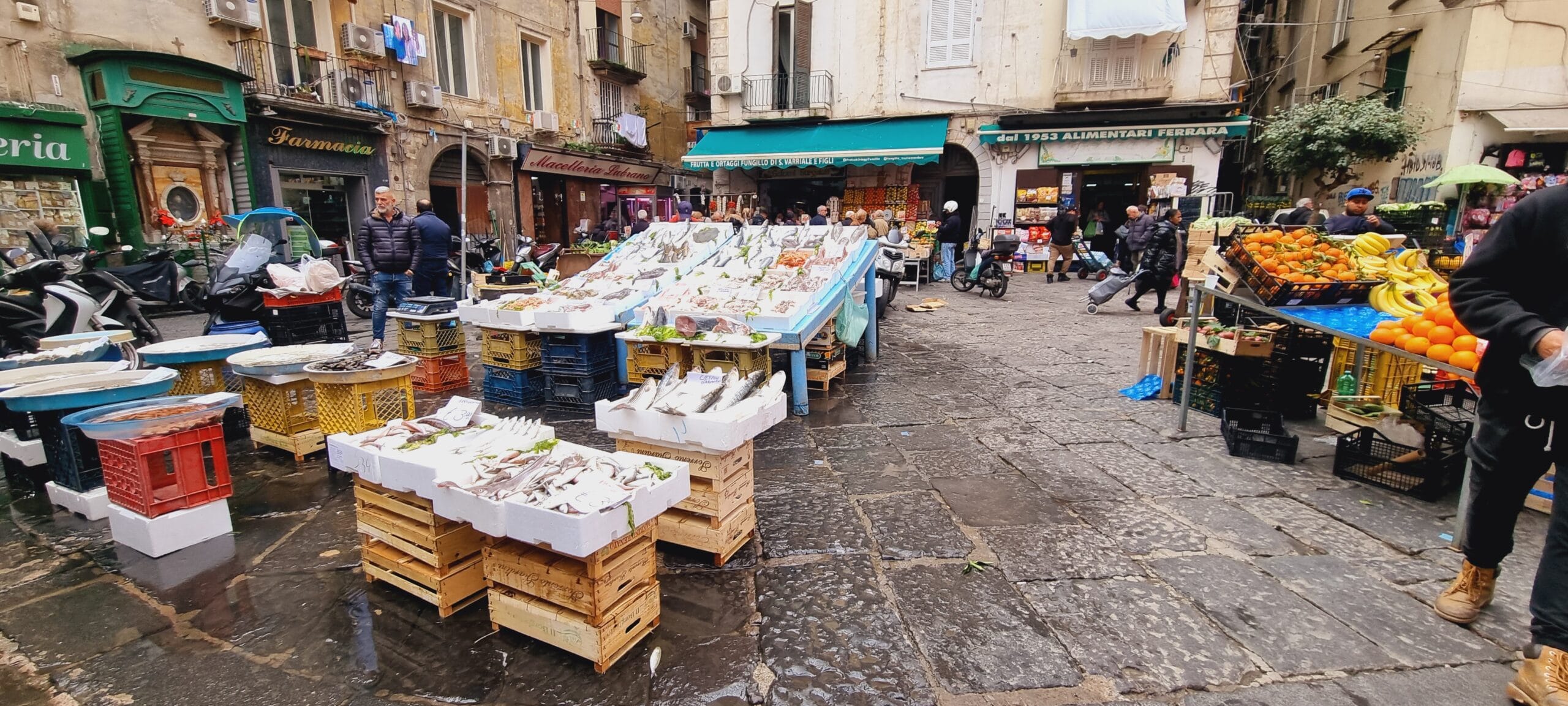
It’s messy, loud, unpretentious — and completely addictive. After a day spent taking in Naples from above, this was the perfect way to come back down to earth.
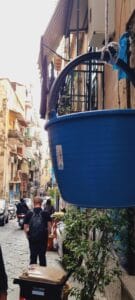 Passing through the market, we narrowly avoided a minor collision, not as you might expect from one of the many scooters, but from one more bit of local genius: ‘o panar.
Passing through the market, we narrowly avoided a minor collision, not as you might expect from one of the many scooters, but from one more bit of local genius: ‘o panar.
With no lifts in most apartment blocks, Neapolitans have mastered the art of the basket lift — a simple rope and bucket system used to send groceries, lunch, or even sharp knives down to the street and back up again. Traditionally wicker, they are now often bright blue, perhaps to alert the unsuspecting tourists passing by below!
Elderly nonnas still rely on it daily, lowering their bright plastic buckets for fresh eggs or a bag of fruit, then hauling them back up with practised ease. It’s clever, practical, a little bit chaotic, and pure Naples. So if you’re ever wandering the backstreets of Campania… look up. Or rather — heads up!
Having already consumed our body weight in fried foods, we opted for something a little lighter, a simple and delicious cup of caprese, with, of course, mozzarella di bufala. A perfect snack to keep us going, and blissfully not fried! After all, this was tour number one, we had to make sure we had enough energy reserves for number two!
Saying a warm arrivederci to Alessandra, we found ourselves at Via Toledo, very close to one of Naples’ other hidden surprises. And we couldn’t resist a peek.
Our day, which had started high above the city, was about to head underground, to what might be the most beautiful metro station in Europe: Toledo.
 Stepping inside feels like diving into another world. Designed by Spanish architect Oscar Tusquets Blanca and opened in 2012, Toledo station is part transport hub, part art installation, part surreal dreamscape. Inspired by Naples’ maritime soul, the station is bathed in luminous blues, shifting light, and sculptural forms that give the illusion of being beneath the sea.
Stepping inside feels like diving into another world. Designed by Spanish architect Oscar Tusquets Blanca and opened in 2012, Toledo station is part transport hub, part art installation, part surreal dreamscape. Inspired by Naples’ maritime soul, the station is bathed in luminous blues, shifting light, and sculptural forms that give the illusion of being beneath the sea.
As we descended the escalators, the city above seemed to fade away. Crater de Luz — a soaring shaft open to the sky — lets sunlight stream through the depths, joining with 144 LED lights to create a shimmering, watery glow.
It was an unexpectedly magical detour: from rooftop views to rumbling calderas, from ancient myths to mopeds and markets — and finally, to this moment of quiet beauty beneath the surface. In Naples, even your commute is a story waiting to be told.
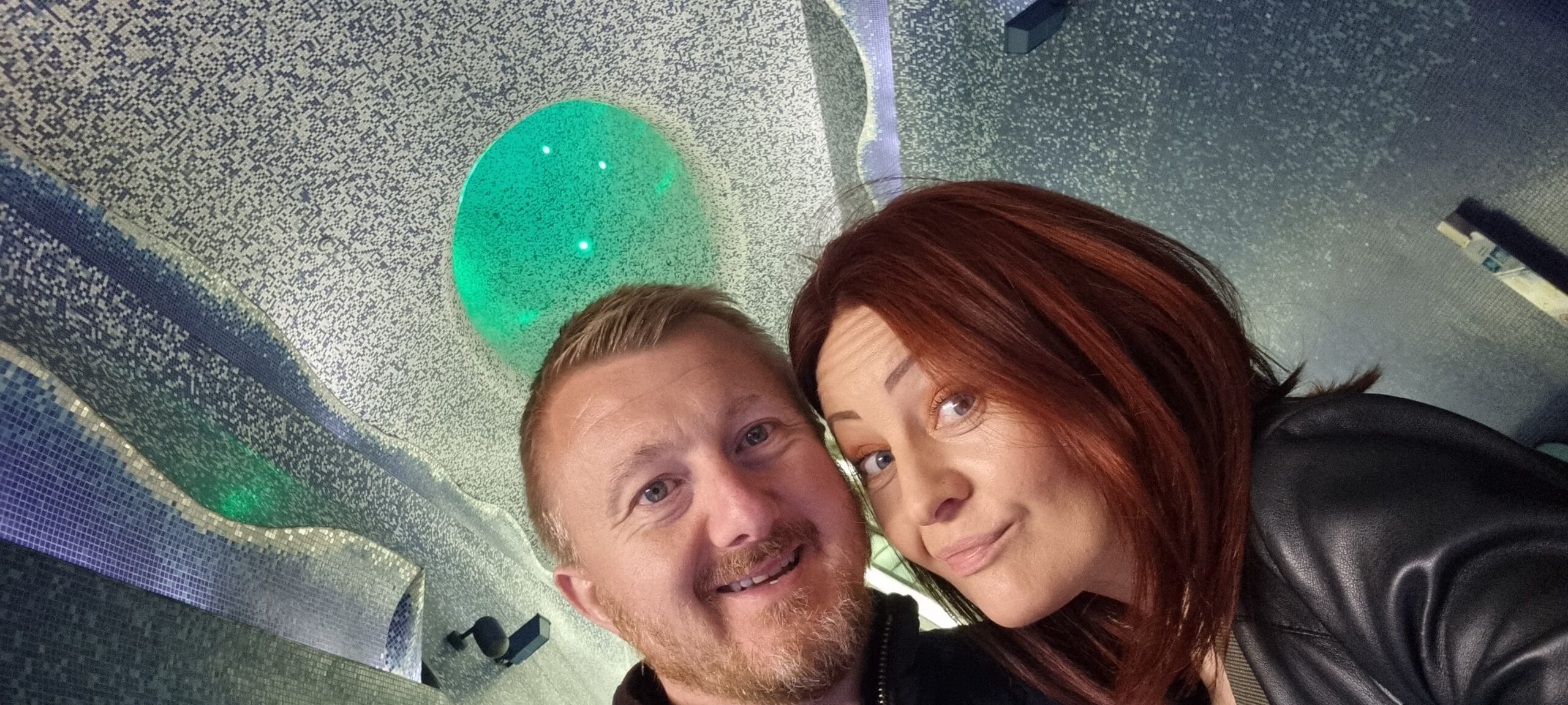
Follow us on instagram @a2z.wander

A2Z Wander | Our Blog A Rainy Arrival (and a Slight Hangover) Lamezia Terme almost didn’t get its own blog post. There’s only so many

A2Z Wander | Our Blog A short coastal train ride punctuated by dramatic thunderclaps brought us further down into Calabria to a town called Scilla.
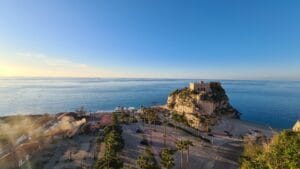
A2Z Wander | Our Blog This is quite the introduction to the town of Tropea… This is the view from Belvedere Piazza del Cannone in

A2Z Wander | Our Blog Three weeks into the trip, and we were finally swapping wheels for waves, boarding our first boat along the coast

A2Z Wander | Our Blog With Sorrento in our rear-view mirror and the sea glittering to our right, we eased into the Amalfi Coast Drive,

A2Z Wander | Our Blog Naples left its indelible mark on us. We were sad to be leaving with so much still unexplored. But, if